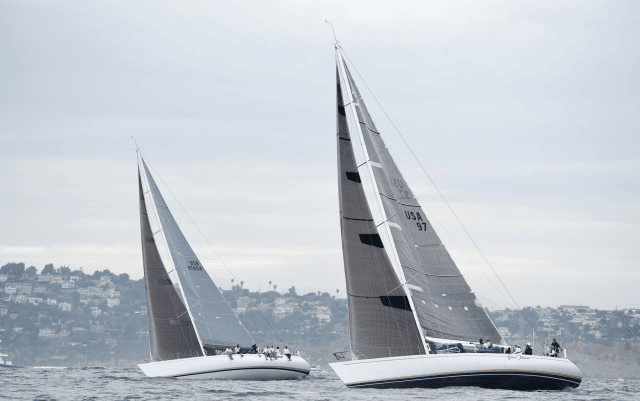
1: Don’t underestimate the need for focus, patience and routine
You can’t give up, you have to stay focused the entire race … The course went much further north than we’ve ever gone before—I’ve only done the one—but with light air for three days, in the first three days we only made 150 miles. So we had to be quite patient. The last day of the race we hit a really bad squall that sent us off in the wrong direction. We were all sort of stunned by that and we had to regroup and get back in the game. We just went back to our routine. Routine is king.
– Erik Gray, Skipper of the SC50 Allure – first place in Division 5
2: Have the right sail for the conditions
We were in the first start on July 13. We cleared the west end of Catalina Island, and our strategy was to go southwest, but the charts said don’t go southwest no matter what. We got pounded for two days with Atlantic Ocean-style waves—a frequency of every two to three seconds and 12-feet-high. We had only one sail onboard that could deal with that tough situation and it was the jib top that Quantum built for us right before the race. Will Paxton did a fabulous job; George Szabo did the service end of it. It powered us through a day and a half of going through a horrendous sea state that no other sail on the boat could have done. It enabled us to be in a position when we came out of that to go like hell. Our hats off big time to Quantum for making a fabulous jib top.
– Erik Gray, Skipper of the SC50 Allure – first place in Division 5
3: Sometimes you have to take one for the team
“You have to expect that things are going to get rough and everybody has to realize that they have to get over anything about themselves. If they’re offended by something, they have to let it go and take one for the team. It has to be a team effort. Things are going to get tense, you have to diffuse the tension and get on with the sailing … Keeping the moral of the crew up, being the one that’s up even if you’re not—that’s a harder job than I thought it would be.”
–Del Olsen, Co-Skipper and Watch Captain of the SC50 Adrenalin – finished seventh in Division 5.
4: It’s not always easy to take the shortest route
“The weather reports were not that great, so we tried to sail the shortest distance for the first half of the race, at about latitude 32. At the halfway point five boats in the class were all within 10 miles of distance to go. We gybed at the halfway point and sailed 1,200 miles to Honolulu on port gybe. The guys who have done it the most knew to play the west side of the course.”
–Sam Heck of Quantum SoCal, Tactician on Rick von Heydenreich’s SC52 Paranoia – fifth in Division 5.
5: Find a balance between conservative and agressive on the line
“Don’t be over early. We didn’t leave a lot on the racecourse; it was tight. We could have cut the corners from the weather grids. We took them for what they were saying and I think I would have shaved the corners off and smoothed out our course a little bit. We sailed 12 miles further than Lucky Duck, and being over early didn’t help. I should have been a little less conservative and stomped on the throttle all the time. We didn’t make very many mistakes; the over early thing was to avoid a collision. People always say, why are you pressing the start so hard. Well, to get clear air, going to Catalina, you want to get there first, you can control things off the bat. The four top finishers in our class all finished within an hour of each other. It becomes more like an in-shore race. We fought everyone on the screen.”
–Bill Durant, Skipper/Owner of the SC52 Relentless – third to finish in Division 5 and corrected to fourth.
6: Be prepared to adjust to sudden changes
“The modern boats with asymmetrical kites really put a premium on always staying pressed up a little bit as opposed to the traditional squared-back running mode … We used to sail with eight people and square the pole back and we always had good drivers and we were very efficient at running and sailing deep. The other boats with bigger budgets and more time went about learning how to sail better and spent time with the designers, ratings, and sail inventory, and started sailing with bigger crews at hotter angles. In 2013 we didn’t have an answer to that. This year we put it upon ourselves to change our mode a little bit; to sail the boat hotter to its polars, and it was faster. “When you’ve been racing the boat for 20-something years with this core group of people, as technology changes and sail technology changes, and computer understanding of how to get more out of the boat, to sail to the targets and to the router, you have to be evolving the boat. In any kind of competition, if you’re static, you’re going nowhere.”
–Will Paxton of Quantum Pacific, Watch Captain on James McDowell’s SC70 Grand Illusion – winner of Division 3 and the overall Transpac title.









